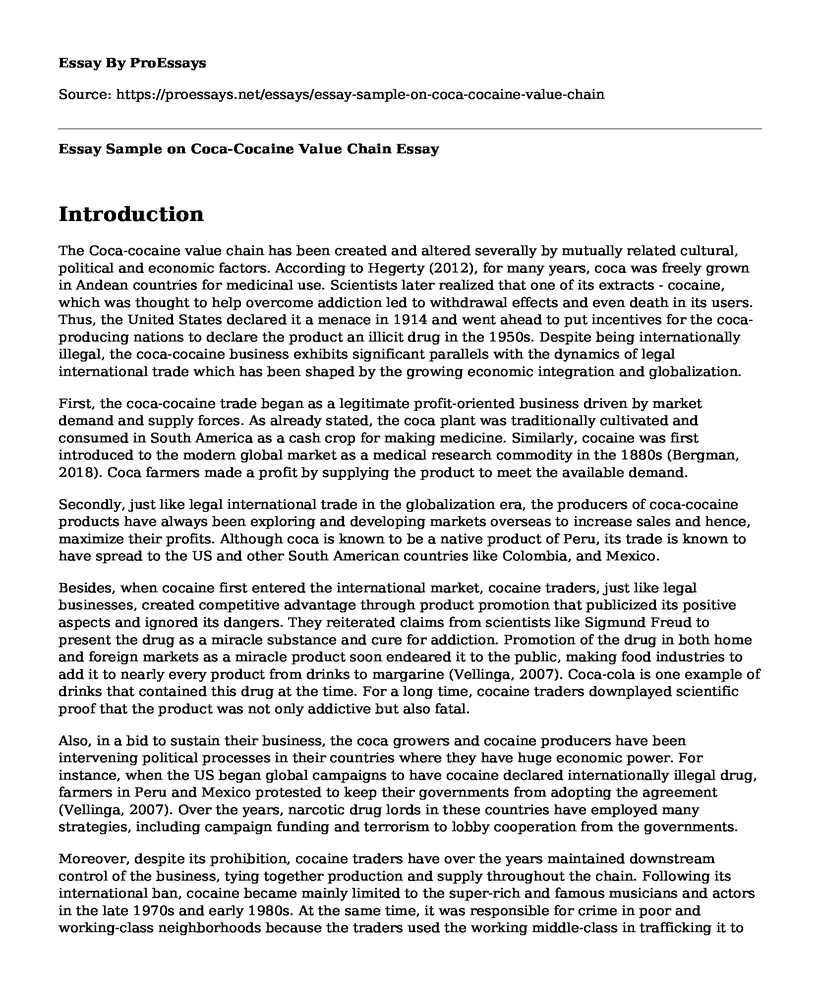Introduction
The Coca-cocaine value chain has been created and altered severally by mutually related cultural, political and economic factors. According to Hegerty (2012), for many years, coca was freely grown in Andean countries for medicinal use. Scientists later realized that one of its extracts - cocaine, which was thought to help overcome addiction led to withdrawal effects and even death in its users. Thus, the United States declared it a menace in 1914 and went ahead to put incentives for the coca-producing nations to declare the product an illicit drug in the 1950s. Despite being internationally illegal, the coca-cocaine business exhibits significant parallels with the dynamics of legal international trade which has been shaped by the growing economic integration and globalization.
First, the coca-cocaine trade began as a legitimate profit-oriented business driven by market demand and supply forces. As already stated, the coca plant was traditionally cultivated and consumed in South America as a cash crop for making medicine. Similarly, cocaine was first introduced to the modern global market as a medical research commodity in the 1880s (Bergman, 2018). Coca farmers made a profit by supplying the product to meet the available demand.
Secondly, just like legal international trade in the globalization era, the producers of coca-cocaine products have always been exploring and developing markets overseas to increase sales and hence, maximize their profits. Although coca is known to be a native product of Peru, its trade is known to have spread to the US and other South American countries like Colombia, and Mexico.
Besides, when cocaine first entered the international market, cocaine traders, just like legal businesses, created competitive advantage through product promotion that publicized its positive aspects and ignored its dangers. They reiterated claims from scientists like Sigmund Freud to present the drug as a miracle substance and cure for addiction. Promotion of the drug in both home and foreign markets as a miracle product soon endeared it to the public, making food industries to add it to nearly every product from drinks to margarine (Vellinga, 2007). Coca-cola is one example of drinks that contained this drug at the time. For a long time, cocaine traders downplayed scientific proof that the product was not only addictive but also fatal.
Also, in a bid to sustain their business, the coca growers and cocaine producers have been intervening political processes in their countries where they have huge economic power. For instance, when the US began global campaigns to have cocaine declared internationally illegal drug, farmers in Peru and Mexico protested to keep their governments from adopting the agreement (Vellinga, 2007). Over the years, narcotic drug lords in these countries have employed many strategies, including campaign funding and terrorism to lobby cooperation from the governments.
Moreover, despite its prohibition, cocaine traders have over the years maintained downstream control of the business, tying together production and supply throughout the chain. Following its international ban, cocaine became mainly limited to the super-rich and famous musicians and actors in the late 1970s and early 1980s. At the same time, it was responsible for crime in poor and working-class neighborhoods because the traders used the working middle-class in trafficking it to both the rich and the poor as well laundering the money made from it.
Lastly, cocaine dealers practice product and technological innovation to overcome hurdles created in the supply chain by security agencies. Many working-class South Americans are involved in the cocaine supply chain in some way and even die because of it. Arguably, a lot of these deaths are because of the heavy-handed way in which both the US and South American governments have cracked down on the manufacture distribution and use of the drug (Bergman, 2018). Hence, cocaine dealers have developed new mechanisms to package the drug, such as dissolving it in soft drinks and transporting it in petroleum tanks.
References
Bergman, M. (2018). The Use of Illegal Drugs in Latin America: A Brief Introduction. Illegal Drugs, Drug Trafficking and Violence in Latin America, 27-41. doi:10.1007/978-3-319-73153-7_3
Bergman, M. (2018). Illegal Markets and the Demand for Illegal Substances. Illegal Drugs, Drug Trafficking and Violence in Latin America, 13-26. doi:10.1007/978-3-319-73153-7_2
Hegerty, S. W. (2012). Exchange market pressure, commodity prices, and contagion in Latin America. The Journal of International Trade & Economic Development, 23(1), 56-77. doi:10.1080/09638199.2012.679292
Vellinga, M. (2007). The Illegal Drug Industry in Latin America: The Coca-Cocaine Commodity Value Chain. Iberoamericana - Nordic Journal of Latin American and Caribbean Studies, 37(2), 89. doi:10.16993/ibero.209
Cite this page
Essay Sample on Coca-Cocaine Value Chain. (2022, Nov 11). Retrieved from https://proessays.net/essays/essay-sample-on-coca-cocaine-value-chain
If you are the original author of this essay and no longer wish to have it published on the ProEssays website, please click below to request its removal:
- Research Paper on MDMA
- Orlando Shooting and Police Militarization Paper Example
- Psychology of Addiction - Research Paper
- Essay Example on Global Poverty and Inequality: A Growing Crisis
- Essay Example on Women's History: Social Impact and Victorian Domesticity in the Early 1960s
- Navigating US Immigration: Laws, Visas, and Citizenship - Essay Sample
- Understanding External Triggers and Psychological Effects of Electronic Addiction - Free Report







